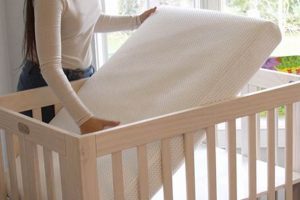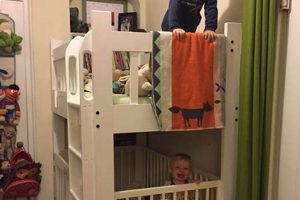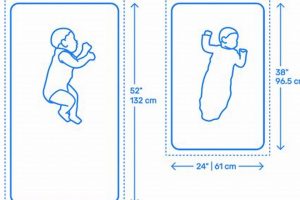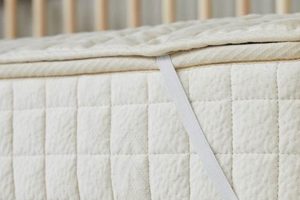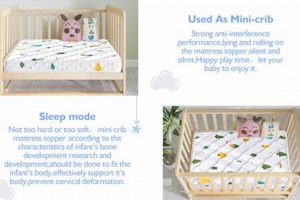Dimensions of a sleeping surface intended for infants and young toddlers confined within the structure of a crib are critical for safety and comfort. For instance, a standard U.S. crib generally requires a mattress approximately 28 inches wide and 52 inches long. Deviation from these standardized measurements can present potential hazards.
Adherence to established dimensional standards minimizes the risk of entrapment and suffocation. The correct fit prevents gaps between the edge of the mattress and the crib frame, thereby reducing the possibility of a child becoming wedged. Historically, inconsistent sizing contributed to preventable infant injuries, prompting the development and implementation of regulations to ensure greater uniformity and safety.
The following sections will elaborate on specific dimensional considerations, material compositions, testing standards, and practical advice for selecting an appropriately sized and safe sleep environment for infants. The goal is to provide a resource that equips caregivers with the knowledge needed to make informed decisions about their child’s sleep safety.
Essential Guidance on Infant Bedding Dimensions
Selecting suitable bedding for a crib requires meticulous attention to detail. Ensuring the correct fit is paramount for infant safety. The following guidelines address key considerations when evaluating options.
Tip 1: Confirm Standard Measurements: Prior to purchase, verify that the selected bedding adheres to the established standard for full-size cribs: approximately 28 inches in width and 52 inches in length. Non-standard bed frames may necessitate custom-sized bedding.
Tip 2: Measure Interior Crib Dimensions: Accurately measure the interior dimensions of the bed frame. These measurements serve as a benchmark when assessing the suitability of potential bedding, minimizing the likelihood of gaps.
Tip 3: Evaluate Edge Support: Assess the firmness of the bedding’s edges. Adequate edge support helps prevent infants from becoming trapped between the bedding and the bed frame.
Tip 4: Consider Mattress Density: Opt for a firm sleeping surface. Firmness is associated with a reduced risk of Sudden Infant Death Syndrome (SIDS). Avoid excessively soft surfaces that could conform to the infant’s face and impede breathing.
Tip 5: Inspect for Gaps: After installing bedding, meticulously inspect for gaps between the bedding and the crib frame. Gaps exceeding two finger widths present a potential safety hazard.
Tip 6: Prioritize Breathability: Select bedding materials that promote airflow. Breathable materials can help regulate infant body temperature and reduce the risk of overheating.
Tip 7: Review Safety Certifications: Prioritize bedding products that have undergone rigorous testing and are certified by reputable safety organizations. Certifications indicate adherence to established safety standards.
Adhering to these guidelines can significantly contribute to creating a safer sleep environment for infants. Prioritizing proper fit and firmness minimizes potential risks associated with inadequate bedding selection.
The subsequent section will delve into specific material considerations and cleaning protocols for maintaining a hygienic sleep environment.
1. Standard dimensions
The establishment of standard dimensions for infant sleeping surfaces is a critical safety measure intended to mitigate risks associated with improperly fitted bedding. Standard dimensions, in the context of infant bed dimensions, directly impact safety, compatibility, and regulatory compliance. Adherence to these standards is fundamental in preventing potential hazards within the sleep environment.
- Regulatory Compliance
Standard dimensions are often mandated by governmental regulations and safety organizations. Compliance ensures that manufacturers adhere to minimum safety requirements, reducing the risk of injury or death. For example, the Consumer Product Safety Commission (CPSC) in the United States sets standards that define acceptable dimensions, materials, and testing protocols. Deviation from these standards can result in legal ramifications and product recalls.
- Gap Prevention
Precise dimensions are essential for preventing gaps between the sleeping surface and the bed frame. Gaps exceeding two finger widths pose a suffocation and entrapment hazard. Standard dimensions, when correctly applied, minimize the likelihood of such gaps, thereby enhancing infant safety. Consistent adherence to these measurements during manufacturing and assembly is vital.
- Compatibility and Interchangeability
Established dimensions facilitate compatibility across different brands and models. Caregivers can confidently select bedding accessories, such as fitted sheets, knowing they will fit securely. Without standardized dimensions, selecting compatible accessories becomes challenging, potentially leading to improper fits and increased risk.
- Reduced Risk of Suffocation and Entrapment
Standard dimensions directly correlate with a reduced risk of suffocation and entrapment. When infant bedding adheres to established measurements, the likelihood of a child becoming wedged between the mattress and the bed frame is significantly diminished. Consistent adherence to these standards contributes to a safer sleep environment.
The correlation between standardized dimensions and infant safety is undeniable. Compliance with established standards, rigorous testing, and consistent manufacturing practices are crucial to ensuring that infant bedding products provide a safe and secure sleeping environment. The implementation and enforcement of these standards are essential for safeguarding infant health and well-being.
2. Thickness tolerances
Thickness tolerances represent an allowable range of variation in the vertical dimension of an infant sleeping surface. These tolerances, while seemingly minor, have significant implications for the safe and effective utilization within a crib structure.
- Adherence to Safety Standards
Safety standards, as defined by regulatory bodies such as the Consumer Product Safety Commission (CPSC), specify acceptable thickness ranges. Exceeding the upper or lower limits can compromise the intended fit and function. For instance, a sleeping surface that is too thick may create an unsafe angle, increasing the risk of infant roll-out, while one that is too thin may not provide adequate support.
- Impact on Crib Rail Height
The height of the crib rails is calculated with the expected thickness of the sleeping surface in mind. Deviations beyond the established tolerances can reduce the effective height of the rails, thereby increasing the risk of the infant climbing out. Consistent thickness within tolerance limits ensures the intended safety features of the crib are maintained.
- Influence on Support and Comfort
Thickness contributes directly to the level of support and comfort provided to the infant. Insufficient thickness may result in inadequate spinal support, potentially affecting the infant’s posture and comfort. Proper thickness, within tolerance ranges, ensures appropriate support and promotes healthy spinal alignment.
- Compatibility with Fitted Sheets
Fitted sheets are designed to accommodate a specific range of thicknesses. Significant variations in thickness, exceeding the tolerance limits, can lead to improper sheet fit. A sheet that is too tight may compress the sleeping surface, altering its intended firmness, while a sheet that is too loose presents a potential entanglement hazard.
In summary, thickness tolerances are not arbitrary figures but rather integral parameters that directly affect the safety, functionality, and comfort of an infant’s sleep environment. Adherence to these tolerances is essential for ensuring that the product performs as intended and minimizes potential risks.
3. Corner radius
Corner radius, referring to the curvature applied to the corners of an infant sleeping surface, directly interacts with dimensional conformity within a crib structure. The specification of this radius affects not only safety and aesthetics but also the precision of fit within the intended frame.
- Mitigation of Sharp Edges
A primary function of corner radius is the elimination of sharp edges, reducing the risk of injury to infants. A well-defined radius provides a smooth, continuous surface, minimizing the potential for cuts or abrasions. Standards dictate a minimum radius to achieve this safety objective. The dimensions of the mattress influences the need of corner radius or not.
- Dimensional Accommodation Within Crib Frame
The corner radius influences how accurately the sleeping surface fits within the crib frame. A radius that is too large can result in binding and prevent proper seating, while a radius that is too small creates gaps. Optimal corner radius, therefore, must be precisely aligned with the internal dimensions of the crib, including its corner profiles.
- Impact on Fitted Sheet Compatibility
The radius affects the fit and tension of fitted sheets. A poorly designed radius can cause bunching or excessive stretching of the sheet material, compromising its integrity and potentially creating a hazardous sleep environment. Properly matched radius and sheet dimensions are essential for maintaining a smooth, taut surface.
- Influence on Material Durability
The corner radius can affect the durability of the sleeping surface material. A sharp corner is more susceptible to wear and tear, potentially leading to premature degradation of the material. A well-defined radius distributes stress more evenly, prolonging the lifespan of the surface.
The interplay between corner radius and overall dimensions is critical for ensuring a safe, comfortable, and durable sleeping surface for infants. Precise adherence to specifications for radius and dimensions is essential for minimizing risks and maximizing product lifespan.
4. Weight capacity
Weight capacity, when considered in relation to infant bed dimensions, signifies the maximum load the sleeping surface can withstand without compromising structural integrity or safety. This parameter is intrinsically linked to the overall dimensions of the sleeping surface because larger surfaces may necessitate greater weight-bearing capabilities. Exceeding this limit can result in sagging, compression, or even structural failure, thereby creating an unsafe sleep environment for the infant. For instance, a standard size surface, typically 28 inches by 52 inches, is engineered to support the weight of a growing infant up to a specified limit, usually detailed by the manufacturer. Failure to observe this limit can void warranties and, more importantly, jeopardize the safety of the child.
Material composition and construction methods significantly influence the correlation between dimensions and weight capacity. A larger surface constructed from lightweight or low-density materials may possess a lower weight capacity compared to a smaller surface fabricated from high-density, reinforced materials. The design of the support structure beneath the sleeping surface also plays a vital role. For example, a surface with robust internal springs or a solid core can typically withstand greater weight than one with a less substantial support system. Retail products provide information such as ASTM certifications which provide testing reports of product quality.
Understanding the interplay between dimensions and weight capacity is paramount for caregivers seeking to provide a secure sleep environment. Overlooking this factor can lead to premature wear and tear, reduced product lifespan, and, most critically, increased risk of injury to the infant. Manufacturers typically provide clear weight capacity guidelines, and adherence to these recommendations is essential for maintaining the safety and integrity of the infant’s sleeping surface. The consideration of both dimensions and weight capacity is thus integral to informed product selection and responsible usage.
5. Support structure
The support structure within a crib mattress is inextricably linked to its overall dimensions. Dimensions define the physical boundaries, while the support dictates the capacity to evenly distribute an infant’s weight across that area. An undersized or poorly constructed support within a standard-sized mattress, for example, can lead to localized sagging. This creates uneven pressure points, potentially impacting spinal development and increasing the risk of positional asphyxia. Conversely, an excessively rigid support may compromise comfort, disrupting sleep patterns. The dimensions, therefore, dictate the necessary scale and distribution of the supportive elements.
Various support structures exist, each influencing the effectiveness of the surface. Innerspring systems rely on interconnected coils to provide resistance. Foam cores utilize varying densities and compositions to achieve similar load-bearing capabilities. Hybrid models combine both technologies. The choice of support structure is not arbitrary; it must align with the specified dimensions to ensure uniform weight distribution. A larger surface area demands a more robust and comprehensive support system to prevent localized deformation and maintain a level sleeping plane. The type of support may also affect the longetivity of the mattress.
In conclusion, the support structure is not merely an internal component but an integral element dictating the safety and functional integrity of any sleeping surface. Its design and implementation must be precisely calibrated to the dimensions of the bedding to ensure uniform weight distribution, proper spinal alignment, and a reduced risk of sleep-related hazards. Understanding this interconnectedness is crucial for selecting appropriate infant bedding, ensuring both safety and optimal development. Dimensions must be in compliance with any support structure.
Frequently Asked Questions Regarding Infant Bedding Dimensions
This section addresses common inquiries related to dimensions of sleeping surfaces intended for infants, providing clarity and guidance based on established safety standards and best practices.
Question 1: What are the standard dimensions for a full-size infant bed sleeping surface in the United States?
The generally accepted dimensions for a full-size infant bed sleeping surface in the United States are approximately 28 inches wide and 52 inches long. These dimensions are designed to fit securely within a standard-sized infant bed frame.
Question 2: Why is adherence to specific dimensional standards important for infant safety?
Adherence to dimensional standards minimizes the risk of entrapment between the sleeping surface and the bed frame. Gaps exceeding two finger widths can pose a suffocation hazard, making precise fit essential for a safe sleep environment.
Question 3: How do thickness tolerances affect the suitability of an infant bed sleeping surface?
Thickness tolerances define the acceptable range of vertical dimension. Deviations beyond these tolerances can compromise the fit within the bed frame and affect the overall safety and support provided to the infant.
Question 4: What role does corner radius play in infant bed sleeping surface design?
Corner radius refers to the curvature of the sleeping surface corners. Properly designed corner radii eliminate sharp edges, reducing the risk of injury, and ensure a snug fit within the bed frame.
Question 5: How does weight capacity relate to the overall dimensions of the bedding?
Weight capacity indicates the maximum load the sleeping surface can support without compromising structural integrity. Larger surfaces may necessitate higher weight capacities to maintain safety and prevent sagging or deformation.
Question 6: What factors should be considered when evaluating the support structure within an infant bed sleeping surface?
The support structure, whether comprised of innerspring coils or foam, must be designed to evenly distribute the infant’s weight across the sleeping surface. This ensures proper spinal alignment and minimizes the risk of uneven pressure points.
In summary, attention to dimensional standards, thickness tolerances, corner radius, weight capacity, and support structure are paramount for creating a safe and comfortable sleep environment for infants. Neglecting these factors can lead to potential hazards and compromise the well-being of the child.
The following section will provide guidance on selecting appropriate bedding materials and maintaining a hygienic sleep environment for infants.
Crib Mattress Sizes
This exploration has underscored the critical importance of dimensional accuracy in infant bedding. From standardized dimensions to thickness tolerances, corner radius considerations, weight capacity specifications, and support structure designs, each aspect directly impacts the safety and well-being of infants. Adherence to established standards minimizes risks associated with entrapment, suffocation, and improper spinal alignment. Deviation from these established parameters can compromise the integrity of the sleep environment, potentially leading to hazardous conditions.
Given the gravity of potential consequences, stakeholders, including manufacturers, retailers, and caregivers, must prioritize dimensional precision in crib mattress selection and usage. Continual vigilance and adherence to safety guidelines are not merely recommended, but imperative. The dimensions of infant bedding are more than mere measurements; they are a foundation for infant safety and healthy development.


